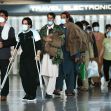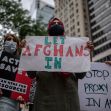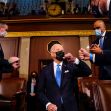Following the largest airlift in American history, thousands of Afghan refugees are figuring out what comes next as they recover from the chaotic evacuation process and settle into their new reality.
Before the Taliban’s total domination of the country, Afghan refugees made up roughly 10% of the world’s refugee population. Between 2001 and July 2021, only 21,000 Afghan refugees resettled in the United States, according to the Council on Foreign Relations. And even before the Taliban takeover, nearly 76,000 afghans entered the states under a special immigrant visa or SIV as it’s commonly referred to. These special visas were granted to Afghans and their families in return for serving alongside U.S. troops during the war.
Now that the decades-long war has come to a close, Afghan migrants who rightfully earned their SIVs along with other refugees are now looking to the future with questions of what comes next.
Over the past two weeks, Afghans who fled the country have begun to trickle into the United States. While it’s unclear how many Afghans will be settling in the states, it is estimated that the number could be anywhere between 20,000 and 22,000. This number could potentially go up as Afghans who are granted visas will also be allowed to bring with them their spouse and children.
First Afghans Arrive in the U.S.
Last week, the first group of refugees arrived in Northern Virginia. Among them was 32-year-old Sayed Harris. Harris was one of the lucky Americans who were able to escape days after the Taliban took hold of Kabul. Harris was visiting his home country and had been there for roughly six months before the Taliban took over.
Though Harris was able to make his way through the airport gates and secure a flight on a C17, footage of his escape shows the harrowing reality of a gunfire-clad exit that did not discriminate against young and old.
In one video, Harris captures what he explains was “Afghan Special Forces Unit 02 from Jalalabad.” He describes the scene explaining, “they were extremely unprofessional all the way from the beginning of the night. I was there from 2 am and when they opened the gates around 8:15 am, they closed it only after 10 minutes for everyone, and then they went above and beyond to harm and terrorize people. They were hitting young and old. Shooting right next to a little kid’s eardrums.”
After first landing in Qatar where Harris describes escapees as being holed up in a crowded warehouse with only a few bathrooms to share among thousands of refugees, he, along with thousands of others made their way to Germany for further processing. It was there Harris explains, “Our tent door wouldn't close and the cold air was gushing through my nose. And combined with me losing my voice in Qatar because I had to yell nonstop at unruly Afghans to maintain law and order because the Airmen couldn't do it.”
Shortly after returning to the states, Harris explains that it was just days after landing that he ended up going to the emergency room with what he described as exhaustion and Covid like symptoms.
As soon as Harris landed in the U.S., the turmoil only escalated back in his home country. “A friend of mine, Baharatullah, who is sitting next to me doesn't know whether to feel happy that he landed in America or to be sad because the first thing on the news was that his infant cousin was killed today in the Kabul Airport blast,” Harris posted on Facebook moments after landing in the U.S.
Resettlement Programs Stressed Following Trump-Era Cuts
Harris's story of escape is harrowing, yet not unique to Afghans following the conclusion of the war. Hundreds of thousands of Afghan refugees are now connected by the same thread of violence, displacement, and uncertainty following what has been described as a messy and hasty exit by Republicans and Democrats alike.
Harris too shares his frustration with the mishandling of the exit. “The U.S. shouldn't have left Bagram airfield prior to their complete withdrawal so that they didn't have to hijack Kabul airport in such a chaotic manner.”
While the airlift has been seen as a success in the eyes of the current administration, the backlash continues to unfold as it remains unclear how many refugees will settle into the states and where they will go. This will be especially tricky to sort out considering the Trump administration notably slashed refugee admissions to record lows. For fiscal year 2021, just over 6,000 refugees resettled in the states compared to the nearly 85,000 who resettled in fiscal year 2016 according to the Migration Policy Institute.
When asked about what he thinks should come next for Afghans seeking safety in the states, Harris explains, “The U.S. should have integration programs for the refugees as half of them are from rural Afghanistan who probably never set foot in a city besides Kabul.” “Most of them do not speak English,” He adds.
As resettlement numbers dwindled to record lows during Trump’s administration, so too did the funding for refugee resettlement programs. A lasting implication of this has been the closure of at least 100 refugee resettlement offices throughout the nation according to Refugee Council USA.
In an attempt to help with the overwhelming stress refugee resettlement programs are expected to face, president Biden announced late Wednesday that he has picked Lee Wolosky to help coordinate the resettlement of Afghan refugees who enter the states in the coming weeks if not months.
The former diplomat has an extensive knowledge base behind him. Between 2015 and 2017, Wolosky worked under president Obama’s administration to help repatriate and resettle inmates from Guantanamo Bay. Wolosky was able to successfully resettle dozens of inmates.
Working alongside the White House Counsel’s office and the National Security Council, Wolosky will aid resettlement efforts by providing legal expertise on how to go about resettlement. For many Afghans and Americans alike, this effort appears to be a drop in the bucket after a hasty departure that has forever changed the lives of those who were lucky enough to escape the country.






